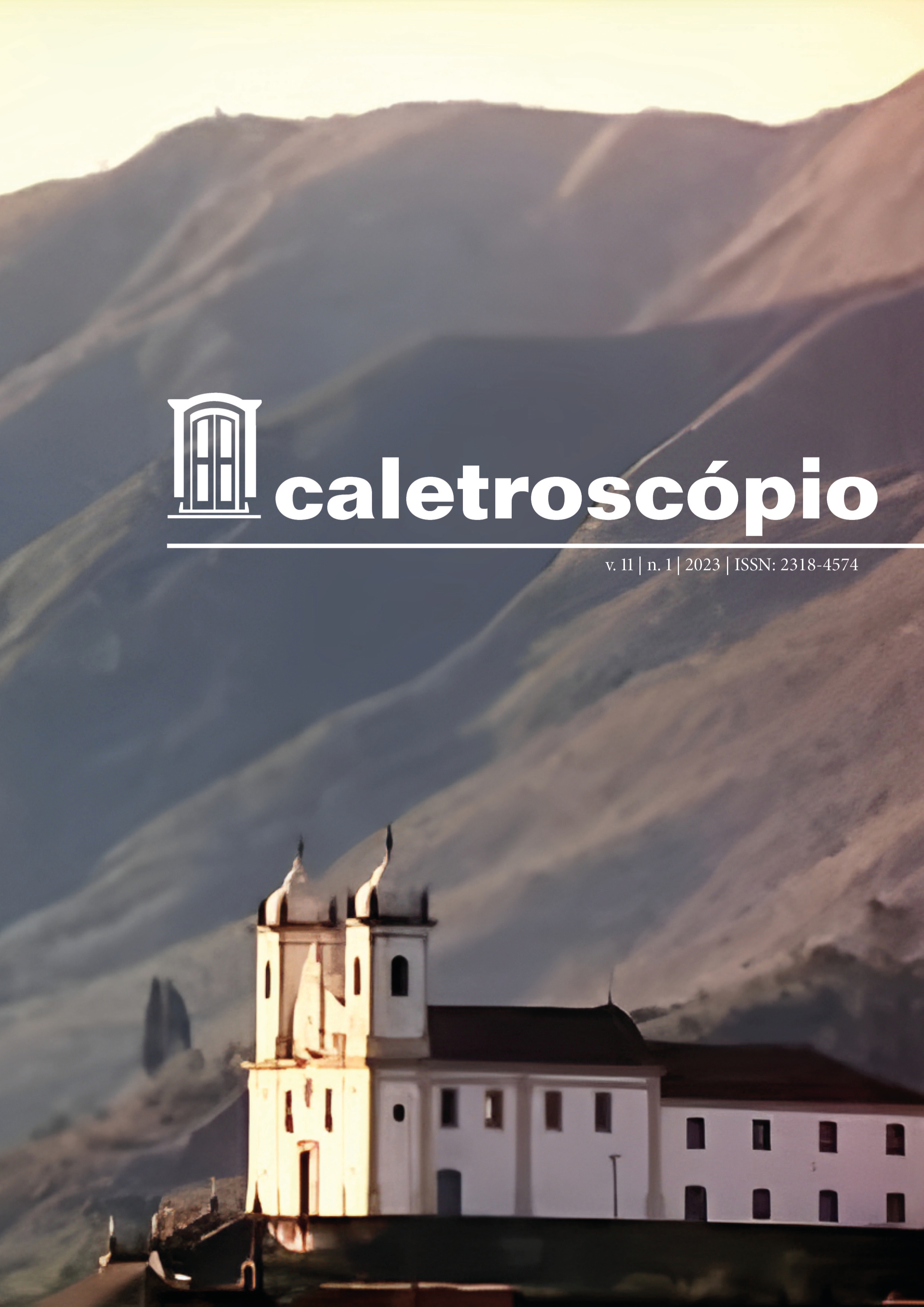Da Vila Rica histórica à mítica
construção do espaço narrativo em Os sinos da agonia, de Autran Dourado
Abstract
In the novel Os sinos da agonia, by Autran Dourado, the journeys of Januário, Malvina and Gaspar, who are involved in a love triangle, are narrated. The characters, facing issues related to death, reflect the decadent atmosphere in the city of Vila Rica, which is experiencing the last grasps of the colonial gold economy. In the unravelling of this web, the narrator defies time and uses the narrated events and the historical background to reach a mythical dimension and reflect upon great universal themes. Our aim with this article, is to verify the way in which the narrative space is built by this narrator, who uses the historical to transcend the mythical. For this, we will take as main the theoretical basis the postulates of Gérard de Génette ([197-]), in Discurso da narrativa and those of Osman Lins (1976), in Lima Barreto e o espaço romanesco.
Downloads
References
ARISTÓTELES. A poética clássica: Aristóteles, Horácio, Longino. Trad. Jaime Bruna. São Paulo: Cultrix, 2014.
BAKHTIN, Mikhail. Teoria do romance II: as formas do tempo e do cronotopo. Trad. Paulo Bezerra. São Paulo: Editora 34, 2018.
BOSI, Alfredo. História concisa da literatura brasileira. São Paulo: Cultrix, 2006.
BRANDÃO, Junito de Souza. Dicionário mítico-etimológico da mitologia grega. v.2 (J-Z). Petrópolis: Vozes, 1991.
CANDIDO, Antonio. Formação da literatura brasileira: momentos decisivos – 1750-1880. Rio de Janeiro: Ouro sobre Azul, 2007.
CHEVALIER, Jean; GHEERBRANT, Alain. Dicionário de símbolos. Trad. Vera da Costa e Silva et al. 33ª edição. Rio de Janeiro: José Olympio, 2019.
DOURADO, Autran. Depoimento. In: SOUZA, Eneida Maria (Org.). Autran Dourado. Belo Horizonte: Centro de Estudos Literários da UFMG, 1996, p.27-64.
DOURADO, Autran. Ópera dos mortos. Rio de Janeiro: Rocco, 1999a.
DOURADO, Autran. Os sinos da agonia. Rio de Janeiro: Rocco, 1999b.
DOURADO, Autran. O risco do bordado. Rio de Janeiro: Rocco, 1999c.
DOURADO, Autran. Novelário de Donga Novais. Rio de Janeiro: Rocco, 2000a.
DOURADO, Autran. Uma vida em segredo. Rio de Janeiro: Rocco, 2000b.
DOURADO, Autran. Tempo de amar. Rio de Janeiro: Rocco, 2004.
DOURADO, Autran. Teia. In:_____. Novelas de aprendizado. Rio de Janeiro: Rocco, 2005a, p.13-88.
DOURADO, Autran. Uma poética de romance: matéria de carpintaria [recurso eletrônico]. Rio de Janeiro: Rocco Digital, 2014.
ELIADE, Mircea. Mito e realidade. Trad. Pola Civelli. São Paulo: Perspectiva, 2006.
GENETTE, Gérard de. Discurso da narrativa. Trad. Fernando Cabral Martins. Lisboa: Vega, [197-].
HAMON, Philippe. Para um estatuto semiológico da personagem. In.: ROSSUM-GUYON, Françoise Van; HAMON, Philippe; SALLENAVE, Danièle. Categorias da narrativa. Trad. Fernando Cabral Martins. Lisboa: Vega, [19--].
HESÍODO. Teogonia: a origem dos deuses. Estudo e tradução Jaa Torrano. São Paulo: Iluminuras, 1995.
LINS, Osman. Lima Barreto e o espaço romanesco. São Paulo: Ática, 1976.
MAXWELL, Kenneth. A devassa da devassa: a Inconfidência Mineira, Brasil-Portugal, 1750-1808. Trad. João Maia. Rio de Janeiro: Paz & Terra, 2001.
TORRANO, Jaa. A quádrupla origem da totalidade. In: HESÍODO. Teogonia: a origem dos deuses. Estudo e tradução Jaa Torrano. São Paulo: Iluminuras, 1995, p.31-39.
Copyright (c) 2023 Caletroscópio

This work is licensed under a Creative Commons Attribution-NonCommercial-NoDerivatives 4.0 International License.
The publication Caletroscopio shall retain for a period of three years all authorial rights for works accepted for publication: articles, reviews, translations, etc. Outside this restriction, these works are licenced through Licença Creative Commons-Atribuição-NãoComercial-SemDerivações 4.0 Internacional.
Upon expiry of this period, in the event that the author publishes the text, even when making alterations to the original, we would ask authors to include as a footnote, the information that a previous version of the article was published in the Revista Caletroscópio, citing the appropriate references.


